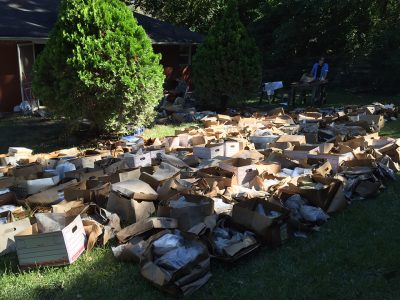New Thematic collection – Intimate Archaeologies of WWII
The forthcoming issue of Historical Archaeology includes a special thematic collection on "Intimate Archaeologies of…
 We live in a moment in which the profession of historical archaeology seems characterized by an odd divide. On the one hand, material things and archaeology are staples of popular culture: a vast range of people seem to be enchanted by material things and everyday histories, and nearly all of us can tell stories of communities and students whose lives have been shaped by historical archaeology in modest and consequential ways alike. On the other hand, though, the discipline is under fire in the face of a withering economy, a government shutdown, a wave of political critics, and a steady flow of well-trained archaeologists growing desperate for employment. The very things we and many of our constituencies are so interested in may be simultaneously receiving their professional death rites.
We live in a moment in which the profession of historical archaeology seems characterized by an odd divide. On the one hand, material things and archaeology are staples of popular culture: a vast range of people seem to be enchanted by material things and everyday histories, and nearly all of us can tell stories of communities and students whose lives have been shaped by historical archaeology in modest and consequential ways alike. On the other hand, though, the discipline is under fire in the face of a withering economy, a government shutdown, a wave of political critics, and a steady flow of well-trained archaeologists growing desperate for employment. The very things we and many of our constituencies are so interested in may be simultaneously receiving their professional death rites.
Perhaps an “archaeological personality” of sorts is emerging outside our modest scholarly circles; that is, the things historical archaeologists value are fascinating (if not important) to many people: the allure of material culture, the compelling stories of everyday people, and the importance of community heritage all seem to find receptive constituencies. Yet at the same moment the profession in its present form is radically transforming. CRM firms are forced to manage modest budgets while they treat employees fairly; museums and preservation organizations have been gutted; politicians routinely criticize anthropology and archaeology; and even insulated university faculty are soberly advising students about the future of archaeological employment both within and outside the walls of the academy. Just as we seem to be turning everybody into an archaeologist, the profession of scholars doing archaeology for a wage seems under risk.
We may need point no further than the television set to confirm that an archaeological engagement with things and everyday heritage has captured public imagination. That broadly defined archaeological personality is reflected in forms that are sometimes clumsy, shallow, or unethical. For instance, Antiques Roadshow, Storage Wars, and American Pickers are among a host of shows that revolve around pillaging things from attics and storage sheds; a wave of genealogy series illuminate our mass quest for heritage harbored in the lives of anonymous ancestors; cable is littered with alien fantasies and concocted historical mysteries revisiting the builders of the pyramids or Stonehenge; and a wave of metal detecting shows has staked a populist claim on archaeological resources.
There still is thoughtful conventional archaeological fare like Time Team, but many of the popular discourses on things are not especially archaeological in a traditional sense. Instead, they have taken aim on a breadth of prosaic materiality and everyday histories, in some cases with an alarming aversion to scholarship and critical thinking. Television planners recognize that things have a sensuous grasp on our imaginations, and the medium delivers visual appeal, emotional impact, and satisfying (if hackneyed) narratives, all in the service of raw profit. TV may not represent archaeological scholarship at all; instead, it paints a picture of archaeology as programmers wish it would be, turning us into characters and the discipline into a broad fascination with things and the everyday.
Television certainly does archaeological scholarship an injustice by reducing research rigor to a shallow story. Nevertheless, it may be capturing our personalities quite presciently. Many of us were brought to historical archaeology by our fascination with historical tales submerged in conventional scholarship; we enjoy the field, lab, and archival experiences of discovery; we share an engagement with material things; and we are tremendously satisfied to share peoples’ historical stories with them.
It may be that this curiosity, reflectiveness, creativity, and democratic instinct are what we might circumspectly call an “archaeological personality,” and it reaches well beyond our restricted scholarly circles. Every television viewer has material things that inspire deep and even inexpressible feelings; we all have a family tree, and most of us are curious about the characters and tales peopling our bloodlines; and many people are strongly connected to local places that seem unlikely to ever figure in grand historical narratives despite the meaningfulness of their residents’ lives.
It is perhaps intellectually interesting that the narrow focus on excavated things from the past has given way to an archaeology that takes aim on nearly any thing across time and space. Yet on television this has forged a populist picture of material heritage that everyone can feel, participate in, and—if armed with scuba equipment, a metal detector, or an attic ladder—recover for themselves. We may be part of a moment in which what we do and are interested in is appreciated, and the steady traffic in archaeology students seems to confirm persistent commitment to historical archaeology. Yet the rigor of archaeological research and the depth of training for a historical archaeologist seems to be somewhat undervalued and perhaps taken for granted.
Many of the questions about archaeological employment have always provoked some anxiety; scholars, teachers, students, and a host of family members have often been apprehensive about archaeological careers. At this moment, the profession—regardless of whether our salaries come from firms, universities, federal agencies, or any other entity—faces a challenge to rationalize historical archaeology and not simply stake our careers on the presence of historical preservation legislation or the allure of tenure. Practically, some political voices aspire to gut the legislation that revolutionized American historical archaeology; and the number of tenure-stream historical archaeology positions is very modest and certainly not expanding.
Nevertheless, many of us have concrete experiences with lots of people who are committed to archaeology, preservation, and heritage. Many archaeologists at the outset of their careers crowd university hallways and are doing or seeking employment with firms, agencies, and universities. Further, we have all the evidence of archaeology’s power that is provided by imperfect television series.
Lazy politicians and pop commentators commonly use archaeology as an easy critique of the dilemmas of scholarship, budgets, or ideology, and the politicians in particular need to hear from constituents whose stake in historical archaeology cannot be dismissed as spoiled scholars defending intellectual turf and exorbitant salaries. The historical archaeological community worldwide is a rather modest number of professionals, but the communities we impact are enormous. In the US if not the rest of the world, the voices of these non-professionals who are fascinated with our work needs to be mobilized more effectively. The public archaeology events at the SHA conferences are always well-attended, and many of us have wonderful field projects that integrate avocational archaeologists and public constituents in creative and consequential ways.
For the neighborhoods that are changed by your scholarship, ask them to write their Congressional representatives, community politicians, local universities, and the granting agencies that support archaeology so they can tell their stories. So many people seem to be fascinated by our scholarship, but we risk leaving it to be distorted by TV producers or grossly misrepresented by politicians using archaeology as their ideological straw person. The discipline will inevitably change and become ever-more ambitious and interdisciplinary, which is intellectually exciting, but as it changes we need to keep reminding people what historical archaeologists actually do that builds communities in modest but important ways.
